The New IP Strategy Agenda
Rovi Corporation,
Senior VP, WW IP and Licensing
Sunnyvale, CA, USA
Intellectual Assets, Inc.,
President,
Saratoga, CA
Why Intellectual Property is the Key to Success in the Knowledge Economy
How important is intellectual property to a company's balance sheet? Just ask Samsung. The company's shares plummeted nearly 7.5 percent after it lost a patent infringement case to Apple in late August 2012. The ruling erased more than $12 billion dollars from Samsung's market value overnight.1
The global economy is shifting from the manufacturing- based economy of the last century to the knowledge-based, innovation-driven economy of the 21st century. Whereas access to raw materials and factory output helped define success in this last era, access to ideas and the ability to create tangible business value from them will define success in the knowledge economy. We believe this is a long-term, irreversible trend.
The importance of IP to a company—how it is created, how it is managed, how it is deployed—has increased tremendously. Growth driven by innovation is a top priority among many CEOs and IP is the best way to legally own these innovation assets.
IP is Innovation is Business
In fact, a well integrated and fully maximized IP strategy should drive the creation of new products and services for the company. Unfortunately, in this age of co-creation and collaboration, many global companies are still struggling with the correct framework to deploy an IP strategy within their organization. According to Forrester Research, vice president, Navi Radjou, "U.S. firms waste $ 1 trillion in underused IP assets by failing to extract full value through partnerships."2/ In the United States alone, technology licensing has generated an estimated $45 billion annually, with licensing globally approaching $100 billion annually.3 For example, a leading company like IBM has returns from its IP portfolio that are estimated at more than $1 billion annually, which accounts for 12 cents of IBM's earning per share.
According to The Economist, 75 percent of the value of companies is attributable to their intellectual property.4 In addition, data points from the U.S. Department of Commerce serve to emphasize the critical importance of IP:5
- Intellectual-property intensive industries contribute $5 trillion per year to the U.S. economy.
- These industries account for about 35 percent of gross domestic product and 40 million jobs, including 28 percent of jobs in the U.S.
It is clear that a new marketplace has emerged and CEOs worldwide must take a leadership position in driving an effective IP strategy agenda throughout their organization. Executives need to look at IP not as the by-product of other activities, but as an integral part of their business. Not as an expense to be managed, but as capital to be invested and deployed. But how does that actually happen—how does managing innovation and IP lead to sustainable profits? By understanding the three key IP management concepts outlined below, CEO's can lead their teams to achieve profound business results.
Concept One: The IP Hierarchy of Needs
The first concept that CEO's must understand is the business use of intellectual property competencies. Executives are expected to lead companies to produce sustained business growth. In short, this means that a CEO should not surprise shareholders with unexpected results, but instead should derive full value from existing products, services and assets as well as launch new products and services to sustained competitive advantage, using an efficient mix of both in-house and external resources.
Not only are these the business expectations of board members and shareholders, they are of utmost importance to them. The same holds true for the management of intellectual property. In order to fully develop and deploy a successful IP strategy within your organization, one needs to first think of business needs and IP in a hierarchical manner. Without a strong foundation to build upon, IP will just remain a "cost" on the balance sheet and unpleasant litigation "surprises" will occur.
A classic example of how a hierarchical model works that most of us learned in school is Maslow's Hierarchy of Needs. As students we were taught that the most fundamental human need is air to breathe. Once that need is satisfied a search for food sets in. Following these two primary needs, a human looks for shelter and then a community relationship with other individuals.
What Maslow discovered, we now know, also applies to intellectual property. A company must first be competent (able to breathe) before it can successfully move on to higher levels of activity. In Figure 1, we see the activities associated with business success, and the corresponding intellectual property competency, displayed in a hierarchical manner on the pyramid.
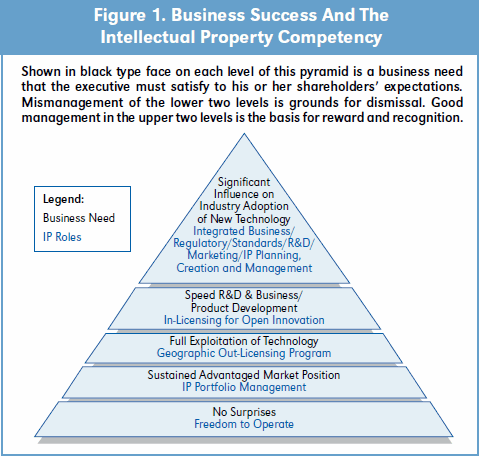
The 5 Levels of Competency
To run a successful business, the first requirement is to avoid any surprises. Surprising your boss, or a corporation's board, is a fast track to the unemployment line. When a business leader puts in place systems that allow the company to operate in a stable, consistent manner, the first level of business success sets in. Intellectual property contributes at this base level by helping to ensure that a company is free to offer its new and profitable products and services.
The patent case of Apple versus Samsung is a prime example of what can go wrong. It shows how devastating a surprise can be to a management team and a company's stock price. When Samsung lost the patent suit with Apple, its stock price dropped 7.5 percent and the CEO was under intense pressure by the corporation's board. Samsung further faces an injunction and exclusion against its key mobile products in the United States.1
Once a business is stable and running smoothly with no surprises, the next challenge for a CEO is to ensure that the company's IP is being used to generate sustained advantaged market positions. This means introduction of new products and services that are superior in cost, performance, or both, compared to the competition. The trick is to accomplish this feat in a manner that will allow that advantaged position to be sustained over time. Intellectual property's contribution to sustaining a market-leading position comes in the strategic acquisition and use of patents, trade secrets, copyrights and trademarks. These, each in their own way, can prohibit a competitor from offering the same product or service. To accomplish this sustained advantage a CEO must ask the right questions and generate the right competencies within the business.
The next level up the business hierarchy, once a company is competent at the first two levels, is to engage in full exploitation of its technology globally. However, there are very few companies in the world that can conduct their business in every country. The company's core competence or sweet spot usually lies in the first or second tier of the hierarchy. When a company is expanding geographically, it builds its regional business into countries in which it knows how to operate. For those countries where it's unfamiliar with doing business, licensing its technology to others who understand the country's nuances, via geographic licensing programs, builds corporate revenues faster than any other method.
Near the top of the pyramid, and only after the other three competencies are mastered, can a company look to put in place business systems that will consistently speed R&D and product development. The role of intellectual property at this level is to integrate business, regulatory, standards, marketing, R&D, and IP activities. Many companies attempt to integrate planning, creation and management strategies and tactics before they've mastered the other levels of the pyramid. But, as Maslow vividly showed us, it's hard to find shelter if you can't breathe.
Finally, at the top of the pyramid, influencing industry adoption is all about maximizing value in the various stages of the company's innovation cycle. As Marc Ehrlich, head of IBM's IP Enforcement and Commercialization business, observed: "In order to control industry adoption of new technologies a CEO must find the proper balance between proprietary protection and open licensing of a technology. To do this requires a deep understanding of the innovation lifecycle for technologies in the company's industry. For example, aggressive IP protection may make sense for early stage technologies whereas a more open licensing model, implemented after market acceptance of a technology, may facilitate industry adoption, thus setting the stage for a next wave of technological innovations for the company."
Concept Two: Build an Action Plan by Assessing Threats and Opportunities
When the executive understands the hierarchical nature of intellectual property management and how it fulfills the business needs of the company, his or her next task is to understand the lay of the land in terms of the company's IP portfolio and its ability to use that IP. Understanding the business and IP landscape is critical for assessing threats and opportunities for the business, which enables the development of an effective strategy and action plan.
A critical component of this action plan should be the creation of an IP dashboard. IP dashboards are used by CEOs, R&D teams, legal counsels and key decision makers to monitor the competitive landscape and to find new opportunities for innovation. They are also used to review large quantities of patent, scientific and product literature.
"Having an effective means to display and interpret critical information for decision makers is as essential to a successful military campaign, as it is driving the growth of a Fortune 100 company," states Colonel Michael Killion, director of operations for U.S.M.C. Operation Khanjari and Moshtarak in Helmand Province, Afghanistan (2009-2010). "When executing combat operations, it is essential to have effective procedures, collaborative tools and dashboards to quickly define the context of the problem to be solved, the available options for resolution, and the comparative risk and benefit associated with each option. In the military, people's lives are at risk. In the business world, it's jobs and real shareholder revenue."
The Rise of the IP Dashboard
An IP dashboard does two things for the executive. First, it provides guidance for his management team on the right way to think about using intellectual property. Second, it is a fast, high-quality, visual way to provide the executive with feedback on the strengths and weaknesses of various aspects of his integrated business and intellectual property management system.
In the early 1990s, as IBM started its transition from a product to a services organization, it tapped the best minds in the industry to learn how to think about service offerings. What they've developed and deployed over the last two decades is a component business model. This is a groundbreaking, structured approach for executives to think about management of their organization.
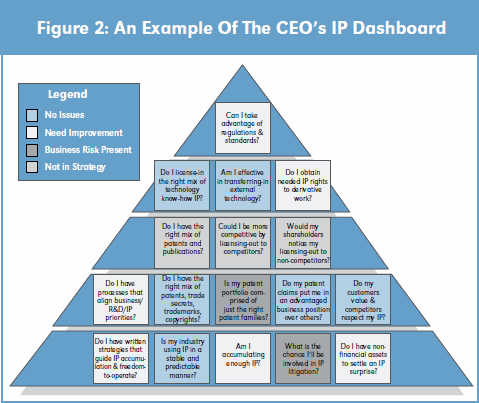 A component business model organizes complex business systems as a set of interrelated components. This organization in turn creates an excellent source of inputs for a dashboard through which a CEO may audit the progress of the modeled business. Building on this proven management approach, components of intellectual asset management can be placed into an executive dashboard and arranged visually to line up with the pyramid's hierarchy of business needs and IP competencies. See Figure 2.
A component business model organizes complex business systems as a set of interrelated components. This organization in turn creates an excellent source of inputs for a dashboard through which a CEO may audit the progress of the modeled business. Building on this proven management approach, components of intellectual asset management can be placed into an executive dashboard and arranged visually to line up with the pyramid's hierarchy of business needs and IP competencies. See Figure 2.
Playing to Win
Perhaps the best example one can give is that of a football coach. The coach sizes up the situation in front of him or her, and deploys those members of the team best able to execute a game plan that will produce a winning result. A CEO who knows the key questions to ask his or her team is better able to gather the information needed for an accurate view of the business landscape.
Such a CEO will get a more precise view of how competitors are deploying and protecting new revenue generating technology worldwide. Armed with this intelligence the CEO can focus on building organizational competencies needed to successfully beat competitors in the marketplace, maximize competitive advantages of the company's portfolio, and build strong and intelligently protected technologies that support profitable business positions for years to come.
The 5 Big IP Threats
Consider the financial services sector. An IP executive dashboard should quickly reveal threats and opportunities, which if not managed, can lead to real revenue loss for financial services companies like American Express, Citibank, and TD Waterhouse. A quick look at the patent landscape reveals there are five significant threats that could surprise and upset traditional financial service companies' plans.
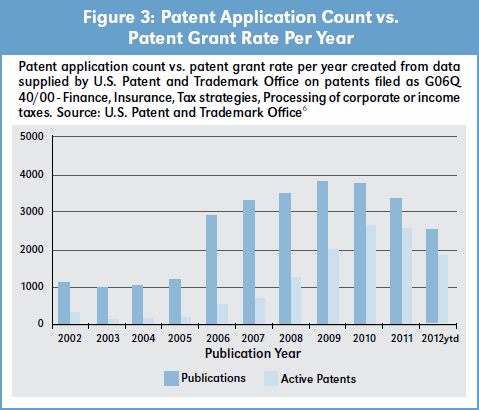 First, there is a high patent application backlog that leads to an inability to freely offer new and improved products that consumers demand. This is shown in Figure 3, which plots the patent application count vs. patent grant rate per year. The difference in the two curves tells a CEO many things about the state of the industry; For example, a recent increased focus on patenting which may coincide with important changes in product and service offers such as digital wallets and other e-commerce solutions. As these new product technologies become covered by patents, competing companies will have to withdraw their offerings, or pay the patent owner's demands for royalties.
First, there is a high patent application backlog that leads to an inability to freely offer new and improved products that consumers demand. This is shown in Figure 3, which plots the patent application count vs. patent grant rate per year. The difference in the two curves tells a CEO many things about the state of the industry; For example, a recent increased focus on patenting which may coincide with important changes in product and service offers such as digital wallets and other e-commerce solutions. As these new product technologies become covered by patents, competing companies will have to withdraw their offerings, or pay the patent owner's demands for royalties.
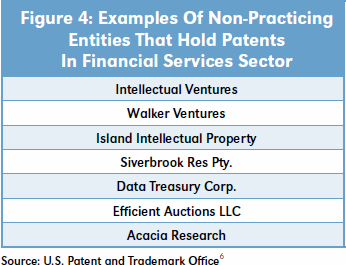 The second threat comes from the relatively large number of non-practicing entities ("NPEs") that hold patents in this field. Figure 4 lists a number of such organizations. Their holdings are significant and likely to grow. Once the market is generating enough profits from patents they hold, industry leaders can expect to be surprised with lawsuits asking for royalties. What's more, the size of patent holdings and rate of NPE patent acquisitions suggest an expectation that the market is heading toward certain technologies and that the operating companies are generating product and service returns that merit the NPE patent investment in this area.
The second threat comes from the relatively large number of non-practicing entities ("NPEs") that hold patents in this field. Figure 4 lists a number of such organizations. Their holdings are significant and likely to grow. Once the market is generating enough profits from patents they hold, industry leaders can expect to be surprised with lawsuits asking for royalties. What's more, the size of patent holdings and rate of NPE patent acquisitions suggest an expectation that the market is heading toward certain technologies and that the operating companies are generating product and service returns that merit the NPE patent investment in this area.
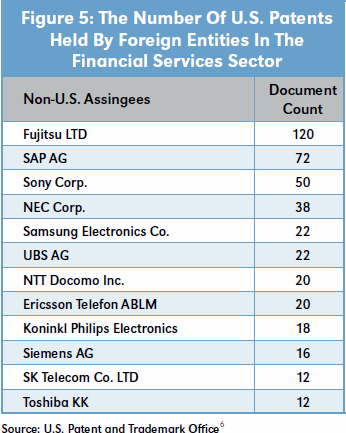 The third threat comes from foreign inventors and inventive organizations. Figure 5 shows the number of U.S. patents held by foreign entities. U.S. financial organizations can expect that such foreign entities may bargain for significantly different terms and geographic access than traditional U.S. based competitors or non-practicing entities. The unknown elements of such future negotiations represent a significant unknowable risk to U.S. growth and global expansion plans of U.S. and European based financial companies.
The third threat comes from foreign inventors and inventive organizations. Figure 5 shows the number of U.S. patents held by foreign entities. U.S. financial organizations can expect that such foreign entities may bargain for significantly different terms and geographic access than traditional U.S. based competitors or non-practicing entities. The unknown elements of such future negotiations represent a significant unknowable risk to U.S. growth and global expansion plans of U.S. and European based financial companies.
The fourth threat comes from the number of applications and patents already filed in foreign countries. Many prime geographic areas for financial services expansion are well covered by patents. Since each foreign jurisdiction has its own rules for patentability, patent enforcement and licensing- financial services companies cannot count on their geographic strategic expansion to proceed without a hiccup, at least not without an integrated IP strategy as part of that expansion. See Figure 6.
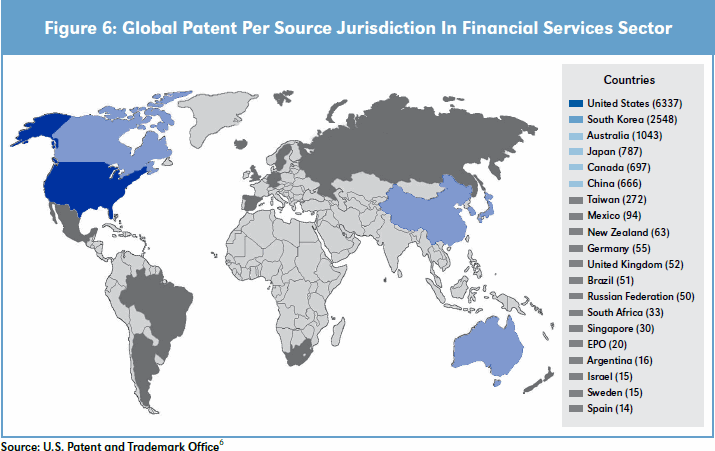
The final major threat to the financial services industry comes from the tech sector, especially as banking and e-commerce begin to truly merge. Financial services institutions want to control emerging technologies like e-wallets and near field payment processing, and some are even partnering with the large tech firms to make it happen (one prime example is the partnership between Google and Citibank on the Google Wallet). But tech companies are patent heavy, and this should be deeply worrying to financial services companies.
In conclusion, answers to the key questions at the bottom of the pyramid—questions like, "What is the chance I'll be involved in IP litigation?"—suggest that financial services companies unfortunately have a very uncertain future ahead of them. To mitigate each risk or even turn them into opportunities requires a thoughtful counter-strategy based on a thorough understanding of the entire IP landscape.
Concept Three: The Right Time for IP
The third concept a CEO needs to understand is that an intellectual property strategy also has a time dependency. This can best be understood via the Scurve most executives became familiar with in business school. This S-curve was a useful tool for simply conveying the best time during a business cycle to invest in the creation of new businesses, grow those businesses, and extract value from mature businesses.
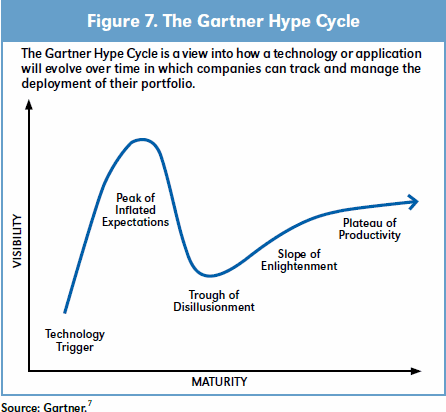 The management techniques appropriate for each portion of the S-curve varied in conjunction with these different objectives. Creation, management, and exploitation of intellectual property also vary along the same curve. However, when it comes to intellectual property management, it is best to extrapolate from the traditional business curve and add two key concepts: The "chasm" made popular by Geoffrey Moore and the "hype cycle" developed by Gartner. See Figures 7 and 8.
The management techniques appropriate for each portion of the S-curve varied in conjunction with these different objectives. Creation, management, and exploitation of intellectual property also vary along the same curve. However, when it comes to intellectual property management, it is best to extrapolate from the traditional business curve and add two key concepts: The "chasm" made popular by Geoffrey Moore and the "hype cycle" developed by Gartner. See Figures 7 and 8.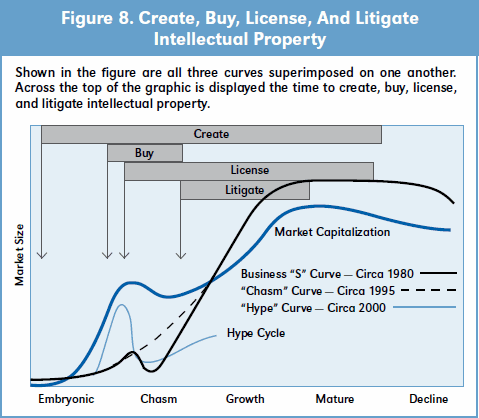
Buy, License and Litigate
By combining the three different curves, executives are provided with the best guidance on when to create, buy, license and litigate intellectual property. As a CEO looks at the business environment and starts to understand which technologies a competitor may choose to bring forward, the hype cycle helps to reveal the right time to invest in a developing technology.
Early in the cycle, patenting activity rises as adoption builds. At this point, the price of intellectual property goes above market expectations. As the market begins to grow the technology usually runs into a few hurdles, including Geoffrey Moore's chasm. It's at the trough of the hype cycle that advantageous licensing can be accomplished by a corporation. If the company was not deploying its own technology (developed either internally or via partnership) early in the cycle, licensing technology in the trough is a good business decision for a company with a solid fast-follower strategy.
Needless to say, it's important not to wait too long to engage in licensing transactions because, as the technology starts to emerge on the far side of the chasm, market size builds, as does the market capitalization of participating startup companies. It is at this point a company may be locked out or required to pay dearly for access to a key technology needed to secure an advantaged market position. It's also noteworthy that, as companies start to pull out of the hype cycle, litigation of intellectual property also occurs. A smart CEO will make sure that the intellectual property that was acquired early on has appropriate patent fences built around a strong core position.
Hype Cycle in Action
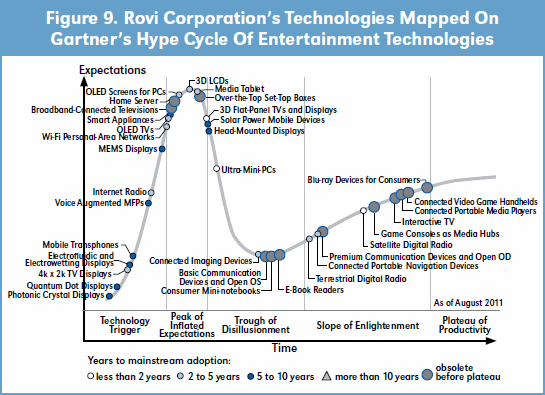 To best illustrate how the hype cycle allows an executive to understand when to create, buy, license and litigate intellectual property, Rovi Corporation's technologies in its pipeline can be shown in a composite Gartner hype cycle below on top of key technology trends in the entertainment / consumer electronics / television industries. In this case study, Rovi shows up with 12 specific technologies indicated by a gray dot outlined with a blue circle in Figure 9.
To best illustrate how the hype cycle allows an executive to understand when to create, buy, license and litigate intellectual property, Rovi Corporation's technologies in its pipeline can be shown in a composite Gartner hype cycle below on top of key technology trends in the entertainment / consumer electronics / television industries. In this case study, Rovi shows up with 12 specific technologies indicated by a gray dot outlined with a blue circle in Figure 9.
Starting at the far right there's a number of technologies that fall into the Gartner "slope of enlightenment." These are technologies headed into commercialization and for which consumer acceptance has been obtained. These markets are predicted to grow rapidly and as such may give Rovi licensing revenues in the process.
Some of these licensing revenues are being reinvested in the early stage (left side) of this cycle at the "peak of inflated expectations." Here Rovi is again wellpositioned with a variety of technologies. Rovi must invest early in a technology to make sure that the intellectual property portfolios are in place and are solid and robust enough to generate good revenues when the technologies emerge and move into the "slope of enlightenment." The core competency for Rovi's management at this point in the hype cycle is to invest in emerging technologies at a realistic price point.
Looking at the center of the graph, at what Gartner calls a "trough of disillusionment," we see that Rovi is positioning itself to invest in technologies that are about to come out of this area and experience growth upon entering the next phase. It is important for a company to invest in technologies and continue their investment in both R&D and IP as these technologies move towards commercialization. Rovi is exhibiting the management perseverance to see such technologies through, and to obtain a return on investment.
The mix of early and late technologies as illustrated on this composite hype cycle shows that Rovi is investing for both current and future revenue streams. Management has the planning skills to know which technologies to invest in early, as well as the discipline to continue to invest in them when others are disillusioned, so that a strong patent portfolio is present when commercialization takes place and increasing revenues are available.
Because Rovi invests along the entire lifecycle, it is expected that the company will obtain a better return on its investment than companies who wait until the last minute to invest, and end up paying above market for the technology they acquire. The recent patent wars occurring in the first and second quarters of 2012 between such players as Google, Facebook, Yahoo, Microsoft, Apple, Samsung, Motorola and others illustrates the point that if one waits until the end to acquire patents, one pays a very high price indeed for acquisition of those assets.
IP: The CEO's Secret Weapon
Managing innovation and IP can indeed lead to sustainable profits. IP that is effectively utilized can provide a powerful competitive advantage in the marketplace. It can also help organizations better understand emerging threats and identify new opportunities. In today's global economy, IP belongs not just in the board room, but in the executive toolkit of every CEO. As the lynchpin of innovation and a gateway to vital new revenue sources, IP is simply too valuable to be outsourced to a patent attorney or outside law firm. By understanding and implementing the three key IP management concepts outlined in this paper, CEOs and their teams can outpace the competition and achieve ground-breaking business results.
Acknowledgement
This article is the first of a les Nouvelles series, planned by the LESI Ad Hoc Committee on Strategy, currently chaired by Subramaniam Vutha. The views expressed herein are those of the authors and should not be attributed to the authors' respective companies.
Sources
http://research.bizreport.com/content24919
- "Samsung shares slump after Apple patent ruling." Market-Watch. August 27, 2012.
- IBM. "A Global Innovation Outlook 2.0 Report." September 2006.
- Andrea Fosfuri. "The Licensing Dilemma: Understanding of the Determinants of the Rate of Technology Licensing." Universidad Carlos III de Madrid, April 2006.
- Economics and Statistics Administration and U.S. Patent and Trademark Office. "Intellectual Property and the U.S. Economy: Industries in Focus." March 2012.
- "A market for ideas." The Economist. October 20, 2005.